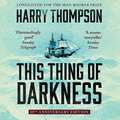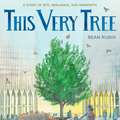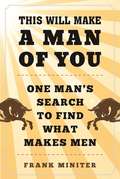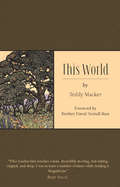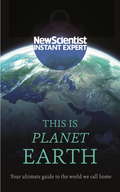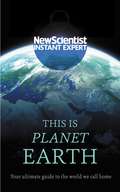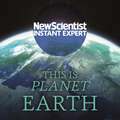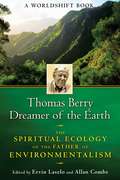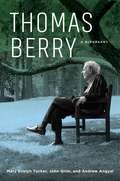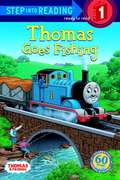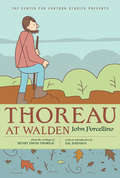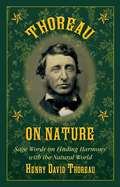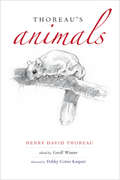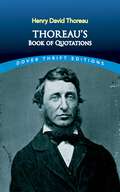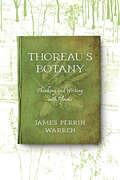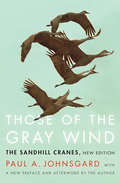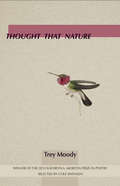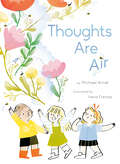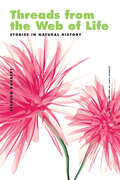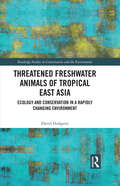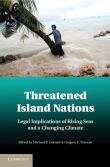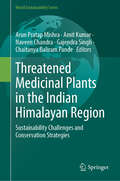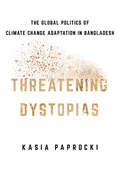- Table View
- List View
This Thing Of Darkness
by Harry ThompsonColin Morgan narrates the action-packed and gripping novel of Charles Darwin's voyage on the Beagle - longlisted for the Man Booker Prize. 'A masterpiece' Bernard Cornwell'A master storyteller' Sunday TimesIn 1831 Charles Darwin set off in HMS Beagle under the command of Captain Robert Fitzroy on a voyage that would change the world. This is the story of a deep friendship between two men, and the twin obsessions that tear them apart, leading one to triumph, and the other to disaster.'An outstandingly good first novel. A[n]... action-adventure combined with subtle intellectual arguments. The meticulous research enriches this fascinating tale' Sunday Telegraph (P) 2021 Headline Publishing Group Ltd
This Tree Counts!
by Sarah Snow Alison FormentoIf you listen carefully to the lone tree behind Oak Lane School, it has a story to tell, about . . . one owl, two spiders, three squirrels, four robins, five caterpillars, six ants, seven crickets, eight flies, nine ladybugs, and ten earthworms, all living safe and free in their tree home. What does this tree need? The children know--it needs friends! Alison Formento's gentle story, illustrated with Sarah Snow's beautiful papercuts, whispers important ideas to all young tree lovers.
This Very Tree: A Story of 9/11, Resilience, and Regrowth
by Sean RubinA deeply moving story about community and resilience, from the point-of-view of the Callery pear tree that survived the attacks on September 11, from Eisner Award-nominated author-illustrator Sean Rubin.* "A resonant, beautifully rendered testament to life and renewal." —Kirkus, starred reviewIn the 1970s, nestled between the newly completed Twin Towers in New York City, a Callery pear tree was planted. Over the years, the tree provided shade for people looking for a place to rest and a home for birds, along with the first blooms of spring. On September 11, 2001, everything changed. The tree’s home was destroyed, and it was buried under the rubble. But a month after tragedy struck, a shocking discovery was made at Ground Zero: the tree had survived. Dubbed the “Survivor Tree,” it was moved to the Bronx to recover. And in the thoughtful care of the New York City Department of Parks and Recreation, the Callery pear was nursed back to health. Almost a decade later, the Survivor Tree returned home and was planted in the 9/11 Memorial to provide beauty and comfort…and also hope. This is the story of that tree—and of a nation in recovery. Told from the tree’s perspective, This Very Tree is a touching tribute to first responders, the resilience of America, and the restorative power of community.
This Will Make a Man of You: One Man's Search for Hemingway and Manhood in a Changing World
by Frank MiniterOne man's quest to becoming a man that Hemingway would be proud to call un compadre.Ben Franklin. Teddy Roosevelt. John Wayne. Babe Ruth. Ernest Hemingway. Looking to follow in the footsteps of these manly men, Frank Miniter decided to go to the places we all agree still make men. This quest led him across the world and finally to a secret fraternity of men who keep an ultimate rite of passage alive.Following the route of the iconic "Papa" Hemingway from Paris to Pamplona with he found that the answers to what happened to manliness, and therefore to what makes men, are in Hemingway's story. Part memoir, part how-to guide, This Will Make a Man of You narrates one man's journey to achieving manliness and uncovers a formula the ancients used to build men of character-a methodology that is still used in the places we all agree still make men. Even better, this formula can help all of us become all we want to be.Through his narrative, Miniter recounts his decision to run with the bulls and his harrowing participation in that intense event with a secretive fraternity of men and women. As he goes he provides readers with sage advice on how they can accomplish their own feats of manliness by using an ancient formula.This is a must-read for every young man looking for a way to become man, for any middle-aged family man seeking adventure, and for all the other types of men in-between. This Will Make a Man Out of You should be read by every red-blooded male.
This World
by Brother David Steindl-Rast Teddy MackerIn the lucid, melodic, various poems of This World, Teddy Macker returns us to the great mystery all around us, a mystery we so easily forget, the mystery of trout, the mystery of orchard, the mystery of our beautiful human bodies. Within these pages, Macker also chronicles the journey inside the whale, telling us not just of fear and trembling but also of the magnificent harps only found in the belly of the beast. By turns ecological, erotic, compassionate, and mystical, these poems return us to "this world, the kingdom we've been looking for."
This is Planet Earth: Your ultimate guide to the world we call home (Instant Expert Ser.)
by New ScientistThe ancient Greeks called it Gaia; the Romans Terra. We know it simply as Earth, the planet we call home. And what a planet it is.Formed around 4.6 billion years ago from the debris of the big bang and long-dead stars, at first it was nothing special, but somehow it evolved to become the most amazing place in the known Universe. The only living planet we know of, it also has a very unusual moon, a remarkably dynamic surface, a complex atmosphere and a deeply mysterious interior.This is Planet Earth is dedicated to the wonders of Planet Earth. Its past is long and dramatic and its future shrouded in mystery. Yet despite centuries of research, only now are we starting to understand Earth's complexity.ABOUT THE SERIESNew Scientist Instant Expert books are definitive and accessible entry points to the most important subjects in science; subjects that challenge, attract debate, invite controversy and engage the most enquiring minds. Designed for curious readers who want to know how things work and why, the Instant Expert series explores the topics that really matter and their impact on individuals, society, and the planet, translating the scientific complexities around us into language that's open to everyone, and putting new ideas and discoveries into perspective and context.
This is Planet Earth: Your ultimate guide to the world we call home (Instant Expert)
by New ScientistThe ancient Greeks called it Gaia; the Romans Terra. We know it simply as Earth, the planet we call home. And what a planet it is.Formed around 4.6 billion years ago from the debris of the big bang and long-dead stars, at first it was nothing special, but somehow it evolved to become the most amazing place in the known Universe. The only living planet we know of, it also has a very unusual moon, a remarkably dynamic surface, a complex atmosphere and a deeply mysterious interior.This is Planet Earth is dedicated to the wonders of Planet Earth. Its past is long and dramatic and its future shrouded in mystery. Yet despite centuries of research, only now are we starting to understand Earth's complexity.
This is Planet Earth: Your ultimate guide to the world we call home (New Scientist Instant Expert)
by New ScientistThe ancient Greeks called it Gaia; the Romans Terra. We know it simply as Earth, the planet we call home. And what a planet it is.Formed around 4.6 billion years ago from the debris of the big bang and long-dead stars, at first it was nothing special, but somehow it evolved to become the most amazing place in the known Universe. The only living planet we know of, it also has a very unusual moon, a remarkably dynamic surface, a complex atmosphere and a deeply mysterious interior.This is Planet Earth is dedicated to the wonders of Planet Earth. Its past is long and dramatic and its future shrouded in mystery. Yet despite centuries of research, only now are we starting to understand Earth's complexity.ABOUT THE SERIESNew Scientist Instant Expert books are definitive and accessible entry points to the most important subjects in science; subjects that challenge, attract debate, invite controversy and engage the most enquiring minds. Designed for curious readers who want to know how things work and why, the Instant Expert series explores the topics that really matter and their impact on individuals, society, and the planet, translating the scientific complexities around us into language that's open to everyone, and putting new ideas and discoveries into perspective and context.
This is Planet Earth: Your ultimate guide to the world we call home (New Scientist Instant Expert)
by New ScientistThis Is Planet Earth is dedicated to the wonders of Planet Earth, the most amazing place in the known Universe.The ancient Greeks called it Gaia; the Romans Terra. We know it simply as Earth, the planet we call home. And what a planet it is.Formed around 4.6 billion years ago from the debris of the big bang and long-dead stars, at first it was nothing special, but somehow it evolved to become the most amazing place in the known Universe. The only living planet we know of, it also has a very unusual moon, a remarkably dynamic surface, a complex atmosphere and a deeply mysterious interior.This is Planet Earth is dedicated to the wonders of Planet Earth. Its past is long and dramatic and its future shrouded in mystery. Yet despite centuries of research, only now are we starting to understand Earth's complexity.ABOUT THE SERIESNew Scientist Instant Expert books are definitive and accessible entry points to the most important subjects in science; subjects that challenge, attract debate, invite controversy and engage the most enquiring minds. Designed for curious readers who want to know how things work and why, the Instant Expert series explores the topics that really matter and their impact on individuals, society, and the planet, translating the scientific complexities around us into language that's open to everyone, and putting new ideas and discoveries into perspective and context.(P)2018 Hodder & Stoughton Limited
Thomas Berry, Dreamer of the Earth: The Spiritual Ecology of the Father of Environmentalism
by Ervin Laszlo Allan CombsA tribute to the visionary contributions and prophetic writings of Thomas Berry, spiritual ecologist and father of environmentalism • Contains 10 essays by eminent philosophers, thinkers, and scientists in the field of ecology and sustainability, including Matthew Fox, Joanna Macy, Duane Elgin, Sean Esbjörn-Hargens, Ervin Laszlo, and Allan Combs • Calls for a transformation of consciousness to resolve today’s global ecological and human challenges • Includes a little-known but essential essay by Thomas Berry When cultural historian and spiritual ecologist Thomas Berry, described by Newsweek magazine as “the most provocative figure among the new breed of eco-theologians,” passed away in 2009 at age 94, he left behind a dream of healing the “Earth community.” In his numerous lectures, books, and essays, Berry proclaimed himself a scholar of the earth, a “geologian,” and diligently advocated for a return to Earth-based spirituality. This anthology presents 10 essays from leading philosophers, scientists, and spiritual visionaries--including Matthew Fox, Joanna Macy, Duane Elgin, Sean Esbjörn-Hargens, Ervin Laszlo, and Allan Combs--on the genius of Berry’s work and his quest to resolve our global ecological and spiritual challenges, as well as a little-known but essential essay by Berry himself. Revealing Berry’s insights as far ahead of their time, these essays reiterate the radical nature of his ideas and the urgency of his most important conclusion: that money and technology cannot solve our problems, rather, we must reestablish the indigenous connection with universal consciousness and return to our fundamental spontaneous nature--still evident in our dreams--in order to navigate our ecological challenges successfully.
Thomas Berry: A Biography (G - Reference, Information And Interdisciplinary Subjects)
by Mary Evelyn Tucker John Grim Andrew AngyalThomas Berry (1914–2009) was one of the twentieth century’s most prescient and profound thinkers. As a cultural historian, he sought a broader perspective on humanity’s relationship to the earth in order to respond to the ecological and social challenges of our times. This first biography of Berry illuminates his remarkable vision and its continuing relevance for achieving transformative social change and environmental renewal.Berry began his studies in Western history and religions and then expanded to include Asian and indigenous religions, which he taught at Fordham University, Barnard College, and Columbia University. Drawing on his explorations of history, he came to see the evolutionary process as a story that could help restore the continuity of humans with the natural world. Berry urged humans to recognize their place on a planet with complex ecosystems in a vast, evolving universe. He sought to replace the modern alienation from nature with a sense of intimacy and responsibility. Berry called for new forms of ecological education, law, and spirituality, as well as the creation of resilient agricultural systems, bioregions, and ecocities. At a time of growing environmental crisis, this biography shows the ongoing significance of Berry’s conception of human interdependence with the earth as part of the unfolding journey of the universe.
Thomas Goes Fishing
by W. Awdry Richard CourtneyThomas often sees his young friends standing by the stream fishing. It looks like so much fun that Thomas wants to go fishing too. One day, he runs out of steam and his driver fills his boiler from the stream. And soon, Thomas' boiler is what the driver is fishing in! In the early 1940s, a loving father crafted a small, blue, wooden engine for his son, Christopher. The stories that this father, the Reverend W Awdry, made up to accompany this wonderful toy were first published in 1945.
Thoreau at Walden (The Center for Cartoon Studies Presents)
by John Porcellino"I am convinced, both by faith and experience, that to maintain one's self on this earth is not a hardship, but a pastime, if we will live simply and wisely." So said Henry David Thoreau in 1845 when he began his famous experiment of living by Walden Pond. In this graphic masterpiece, John Porcellino uses only the words of Thoreau himself to tell the story of those two years off the beaten track. The pared-down text focuses on Thoreau's most profound ideas, and Porcellino's fresh, simple pictures bring the philosopher's sojourn at Walden to cinematic life. For readers who know Walden intimately, this graphic treatment will provide a vivid new interpretation of Thoreau's story. For those who have never read (or never completed!) the original, it presents a contemporary look at a few brave words to live by.
Thoreau on Nature: Sage Words on Finding Harmony with the Natural World (Thoreau For These Times Ser.)
by Henry David Thoreau"How important is a constant intercourse with nature and the contemplation of natural phenomena to the preservation of moral and intellectual health!” --Henry David Thoreau Since his death in 1862, Henry David Thoreau has left an indelible mark on the American mind. A vocal champion of simple living and social equality, he is revered for his tempered prose, gentle words, and wise observations. His most well-known work, Walden, is still read around the world, cherished for both its beautiful writing style and its timeless musings on life, simple living, and nature. Collected in Thoreau on Nature: Sage Words on Finding Harmony with the Natural World are some of Thoreau’s most impactful musings--drawn from the many writings he completed over his lifetime. His work touched on every aspect of living a harmonious life, from respecting your neighbors, whether human or animal, to the joys of a simplified life, free of clutter and distractions. Thoreau on Nature will undoubtedly be an essential resource for anyone seeking to find peace and balance in life.
Thoreau's Animals
by Henry David Thoreau Debby Cotter Kaspari Geoff WisnerFrom Thoreau's renowned Journal, a treasury of memorable, funny, and sharply observed accounts of his encounters with the wild and domestic animals of Concord Many of the most vivid writings in the renowned Journal of Henry David Thoreau concern creatures he came upon when rambling the fields, forests, and wetlands of Concord and nearby communities. A keen and thoughtful observer, he wrote frequently about these animals, always sensitive to their mysteries and deeply appreciative of their beauty and individuality. Whether serenading the perch of Walden Pond with his flute, chasing a loon across the water's surface, observing a battle between black and red ants, or engaging in a battle of wits with his family's runaway pig, Thoreau penned his journal entries with the accuracy of a scientist and the deep spirituality of a transcendentalist and mystic. This volume, like its companion Thoreau's Wildflowers, is arranged by the days of the year, following the progress of the turning seasons. A selection of his original sketchbook drawings is included, along with thirty-five exquisite illustrations by naturalist and artist Debby Cotter Kaspari.
Thoreau: A Book of Quotations (Dover Thrift Editions: Speeches/quotations Ser.)
by Henry David Thoreau Bob BlaisdellTo Emerson and other New England transcendentalists who knew him best, Thoreau often seemed prickly and antisocial. But in his writings he was (and is) a man anyone would treasure as a friend, sounding board, and spiritual advisor -- a man who trafficked in that rarest of commodities, the truth. Even now, almost 140 years after his death, his voice remains clear and compelling, and his truths are as relevant and meaningful as they were in his lifetime.In this treasury of more than 450 striking, thought-provoking excerpts from his writing, you will hear him railing against injustice, giving voice to his love of nature, and advocating the simplicity and conscious living that he brought to fruition during his two-year stay at Walden Pond. "To be serene and successful we must be at one with the universe." "Our life is frittered away by detail.... Simplify, simplify."Grouped under 17 headings, including "Education," "Freedom and Individualism," "Friendship and Love," "Human Nature," "Literature and Writing," "Nature," "Season," and "Solitude," the quotations include such favorites as "The mass of men lead lives of quiet desperation" and "Some circumstantial evidence is very strong, as when you find a trout in the milk." Whatever category they are in, Thoreau's observations provide so much inspiration and intellectual nourishment that browsing through this book becomes an exciting voyage of discovery into the heart of the human condition.
Thoreau’s Botany: Thinking and Writing with Plants (Under the Sign of Nature)
by James Perrin WarrenThoreau’s last years have been the subject of debate for decades, but only recently have scholars and critics begun to appreciate the posthumous publications, unfinished manuscripts, and Journal entries that occupied the writer after Walden (1854). Until now, no critical reader has delved deeply enough into botany to see how Thoreau’s plant studies impact his thinking and writing. Thoreau’s Botany moves beyond general literary appreciation for the botanical works to apply Thoreau’s extensive studies of botany—from 1850 to his death in 1862—to readings of his published and unpublished works in fresh, interdisciplinary ways. Bringing together critical plant studies, ecocriticism, and environmental humanities, James Perrin Warren argues that Thoreau’s botanical excursions establish a meeting ground of science and the humanities that is only now ready to be recognized by readers of American literature and environmental literature.
Those of the Gray Wind: The Sandhill Cranes, New Edition
by Paul A. JohnsgardWith Paul A. Johnsgard, we follow the migration of the sandhill cranes from the American Southwest to their Alaskan breeding grounds and back again, an annual pattern that has persisted over millions of years. By selecting four historic time frames of the migration between 1860 and 1980, Johnsgard illustrates how humans have influenced the flocks and how different American cultures have variously responded to the birds and perceived their value. Each section focuses on the interactions between children of four different American cultures and sandhill cranes, triggered by events occurring during the annual life cycle of the cranes. The story is enriched by the author’s exquisite illustrations, by Zuni prayers, and by Inuit and Pueblo legends. With a new preface and afterword and a new gallery of photographs by the author, Those of the Gray Wind is a classic story of a timeless ritual that can be enjoyed for generations to come.
Thought That Nature
by Cole Swensen Trey MoodyThought That Nature identifies and captures moments when the border between personal consciousness and the otherness of the physical become porous. Ironically, it also allows Moody to measure the distance between consciousness and direct experience, even as he casts this gap in memorable speech. This debut collection offers the reader sensual delight and intellectual pursuit-a rare and bracing combination.
Thoughts Are Air
by Michael ArndtA beautiful and timely book for anyone who needs a little inspiration to turn their dreams into reality.When a trio of friends happen upon a neighborhood tree falling into decay, an idea catches hold. But what makes a dream become a plan, and how does a plan lead to a brighter tomorrow? With deceptively simple verse, Thoughts Are Air brilliantly links thoughts, words, and actions to the water cycle. Just as air becomes water becomes solid matter, thoughts become words become actions. The comparison is subtle yet powerful--air condensing into matter; ideas condensing into doing something that matters. Completely unique and utterly accessible, this is a book to inspire curiosity and spark change-making ideas in readers young and old.
Threads from the Web of Life & The Shark and the Jellyfish: Stories in Natural History
by Stephen DaubertEcology, like all literary narrative, has the potential for turnabout, surprise, lessons learned, and tragedy. The stories in Threads from the Web of Life and The Shark and the Jellyfish describe protagonists, their competitors, and the habitats that provide the setting for their interaction—habitats that have become surprisingly complex with the passage of evolutionary time.One niche moves across a world of flowers that reaches its earliest peak bloom in the low valleys and then peaks later among the slopes of the foothills—a rolling habitat. Another hop-scotches across the ocean floor, compelling its occupants to migrate from the fallen body of one dead whale to the next. Yet another appears in the aftermath of typhoons, requiring its inhabitants to search the tropical coastline for the latest storm landfall.These tales are filled with no less intrigue than other literary works, but they transpire out of the sight of most readers. Once known only to ecologists, in Threads from the Web of Life and The Shark and the Jellyfish, available for the first time in a single deluxe paperback, these stories become accessible to everyone with an interest in natural history.
Threatened Freshwater Animals of Tropical East Asia: Ecology and Conservation in a Rapidly Changing Environment (Routledge Studies in Conservation and the Environment)
by David DudgeonThis book offers a comprehensive account of the current state of inland waters in tropical and subtropical East Asia, exploring a series of case studies of freshwater fish, reptiles, amphibians, birds, mammals and water bodies at particular risk. The book highlights the rich freshwater biodiversity of tropical East Asia and draws attention to the various threats it faces due to human activities and rapid environmental change. It addresses the question of whether the contributions of these animals and habitats, or biodiversity in general, to ecosystem functioning and service provision provide sufficient basis for arguments supporting nature conservation. Drawing on instances from the rivers and lakes of tropical East Asia, the book also asks whether the benefits accruing from intact ecosystems are likely to be enough to ensure their preservation. If the answer to either or both these questions is ‘no’, then what are the prospects for freshwater biodiversity in rapidly changing tropical East Asia? This book will be of interest to students and scholars of biodiversity, conservation, freshwater ecology, ecosystem services and Asian Studies.
Threatened Island Nations
by Michael B. Gerrard Gregory E. WannierRising seas are endangering the habitability and very existence of several small island nations, mostly in the Pacific and Indian oceans. This is the first book to focus on the myriad legal issues posed by this tragic situation: If a nation is under water, is it still a state? Does it still have a seat at the United Nations? What becomes of its exclusive economic zone, the basis for its fishing rights? What obligations do other nations have to take in the displaced populations, and what are these peoples' rights and legal status once they arrive? Should there be a new international agreement on climate-displaced populations? Do these nations and their citizens have any legal recourse for compensation? Are there any courts that will hear their claims, and based on what theories? Leading legal scholars from around the world address these novel questions and propose answers.
Threatened Medicinal Plants in the Indian Himalayan Region: Sustainability Challenges and Conservation Strategies (World Sustainability Series)
by Amit Kumar Gajendra Singh Naveen Chandra Chaitanya Baliram Pande Arun Pratap MishraThe book provides an in-depth analysis of the major issues related to the conservation of threatened medicinal plants in the Indian Himalayan region. The book is a comprehensive resource and sustainability of challenges and conservation strategies that highlights the critical role of medicinal plants in traditional healthcare systems and identifies the significant threats that these plants face due to various anthropogenic and natural factors. The book covers ten major themes that are critical to understanding the sustainability conservation of threatened medicinal plants in the Indian Himalayan region. It provides an essential resource for researchers, policymakers, and practitioners interested in the sustainability conservation of threatened medicinal plants in the Himalayan area. The book provides an overview of the major issues related to medicinal plant sustainability conservation and suggests strategies for the sustainable management of these plants. The authors have provideda comprehensive and insightful analysis of the sustainability conservation status of medicinal plants in the region, highlighting the urgent need for concerted efforts to conserve these valuable resources.
Threatening Dystopias: The Global Politics of Climate Change Adaptation in Bangladesh (Cornell Series on Land: New Perspectives on Territory, Development, and Environment)
by Kasia PaprockiBangladesh is currently ranked as one of the most climate vulnerable countries in the world. In Threatening Dystopias, Kasia Paprocki investigates the politics of climate change adaptation throughout the South Asian nation. Drawing on ethnographic and archival fieldwork, she engages with developers, policy makers, scientists, farmers, and rural migrants to show how Bangladeshi and global elites ignore the history of landscape transformation and its attendant political conflicts. Paprocki looks at how groups craft economic narratives and strategies that redistribute power and resources away from peasant communities. Although these groups claim that increased production of export commodities will reframe the threat of climate change into an opportunity for economic development and growth, the reality is not so simple. For the country's rural poor, these promises ring hollow. As development dispossesses the poor from agrarian livelihoods, outmigration from peasant communities leads to precarious existences in urban centers. And a vision of development in which urbanization and export-led growth are both desirable and inevitable is not one the land and its people can sustain. Threatening Dystopias shows how a powerful rural movement, although hampered by an all-consuming climate emergency, is seeking climate justice in Bangladesh.
